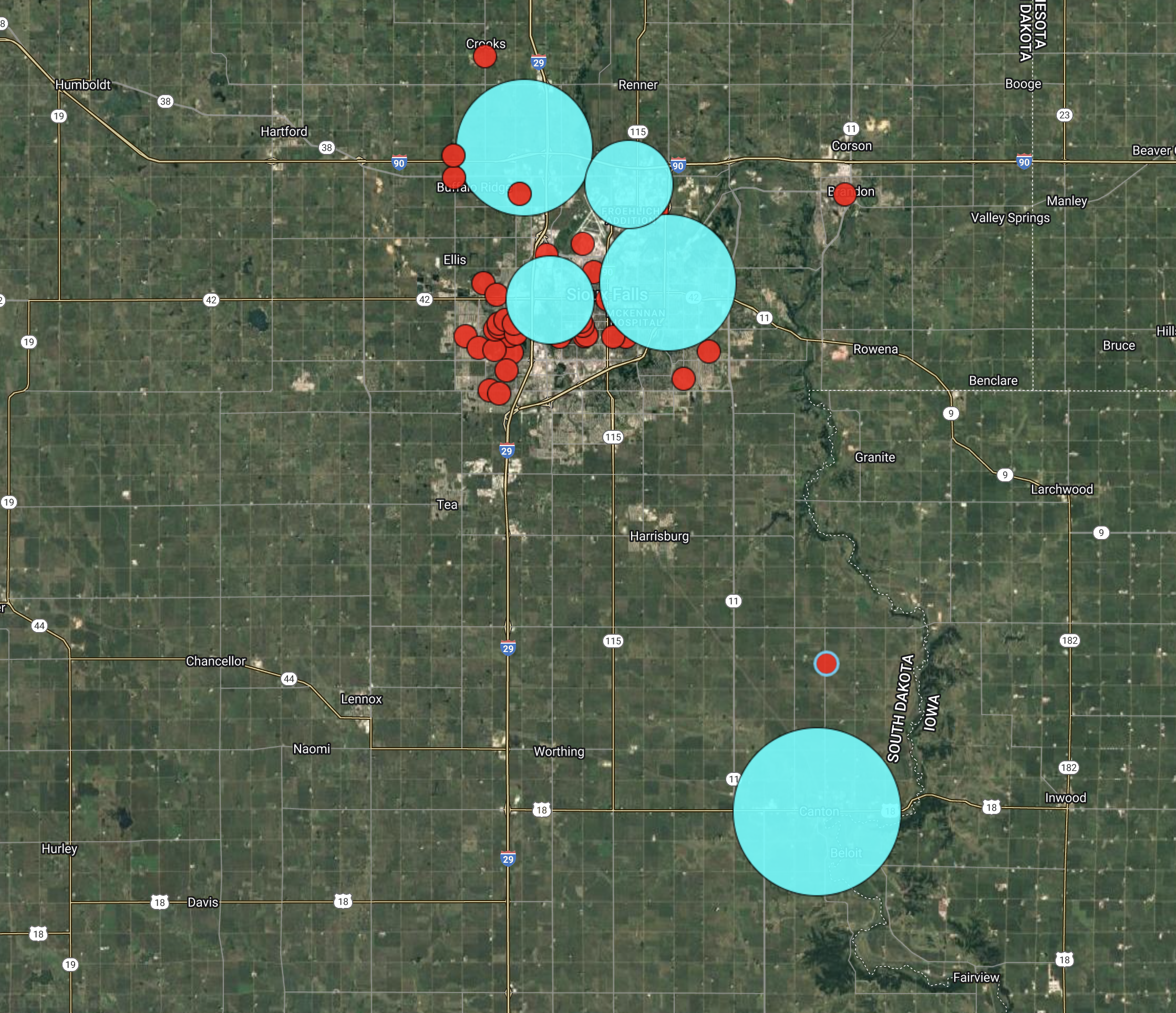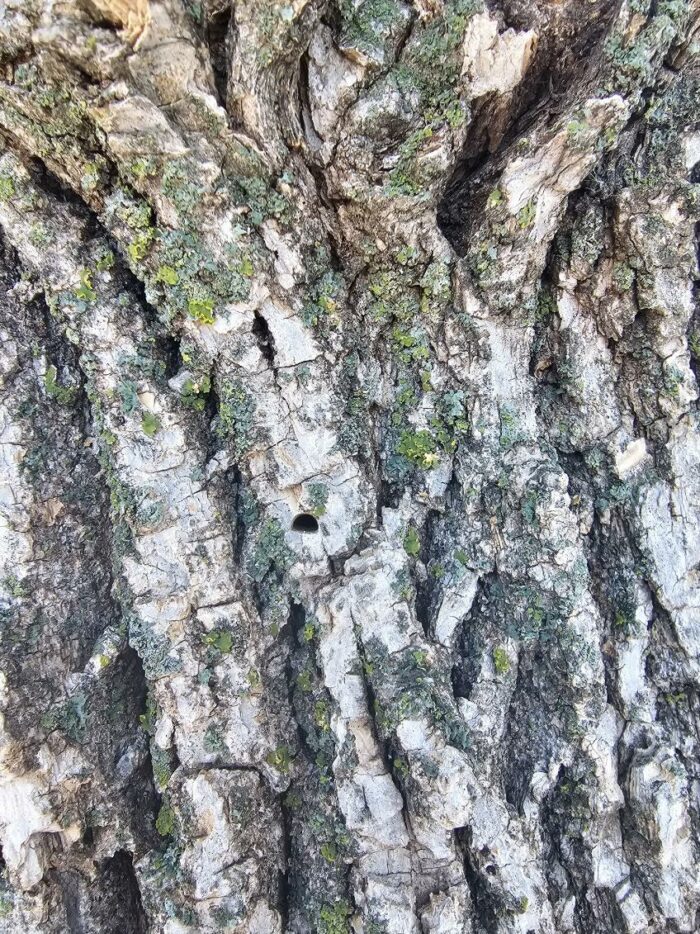Where is Emerald Ash Borer in Sioux Falls – 2024
Emerald Ash Borer was first discovered in Sioux Falls in May, 2018. Six years later, how much has the known population spread and what can we expect in the years ahead?
Background
Biology
Emerald Ash Borer (Agrilus planipennis) is a small insect that attacks trees in the ash (Fraxinus spp.) genera. This includes such trees like green ash (Fraxinus pennsylvanica), white ash (Fraxinus americana), and black ash (Fraxinus nigra), which are native to North America. This will be such a devastating issue for ash because emerald ash borer (EAB) is non-native to North America. Native ash have not evolved with the non-native EAB. The trees do not have the natural necessary chemical defenses to fight off the EAB attacks like they can with our native insects like red headed ash borer (Neoclytus acuminatus), lilac borer (Podosesia syringae), and other native insects. Without any natural protections against attack, the ash are vulnerable to attack from EAB and slowly die (2-5 years) as a result.
When EAB first finds an ash tree its usually by just one or a few adults. A female will lay eggs (about 80) in the cracks of the bark. Its the larvae that will feed on the sapwood just under the bark that damages and eventually kills the tree. And although the adult insect can fly, they are not aggressively flying around to other trees. They typically will stay in one tree (laying more eggs each year) until its just about dead before searching out a nearby tree.
Initially finding EAB in an area can take 4-5 years or more before its obvious to tree owners that the tree is dying. But once that happens, the population has quickly exploded in numbers of adults and larvae (like doubling a penny), and then spreads quickly to surrounding trees just due to shear volume of insects. Click here to learn more about EAB http://(http://www.emeraldashborer.info/)
Professional chemical injections are available to protect the ash from attack. They are very effective if done correctly (99.9%) and maintained on a regular schedule (every 24 months).
History in Sioux Falls
The initial find of EAB in northern Sioux Falls in 2018 was determined by researchers at South Dakota State University to have been there for about 4 years before discovery. Since that time EAB has spread throughout Sioux Falls (more below) and discovered in nearby communities (Canton, Brandon, Crooks). Those “satellite” populations of EAB in surrounding communities got there not from insect flight, but from unintentional human movement through moving ash wood (firewood). It is important to remember these are only the areas that have been discovered. It is very possible and likely EAB is in other communities or surrounding areas. But insect populations are low enough to not suspect infestation.
Known EAB Locations
Below is an aerial view of Sioux Falls with dots representing the known areas with EAB infested trees as of fall 2023. Much of this information was graciously shared with me from researchers at South Dakota State University as part of a research study (Thank you!). Click on the photo to enlarge it. The red dots represent areas with at least one infested ash tree. The big blue dots represent areas with heavy infestation of multiple trees. Those blue dot areas I have personally observed dead and or visibly dying ash from EAB.

Analysis of the Map
There are a few things to consider when looking at the dots on the map. First, the red dot locations are just from random sampling (research). Meaning the ash that have EAB is from random chance finding, not because the researchers are out looking for infested ash in every location. I selected to only show the infested locations and not all the sampling locations.
Secondly, the red dots are not representing severity of infection. I added in the Blue dot locations because I have personally observed severe infection in those locations. The red dots COULD be a single tree discovered by sampling and not showing visible signs of infection yet, or COULD be multiple trees with visible signs of infestation. The take away from the red dots, is that EAB has spread all throughout the city.
Lastly, the blue locations are likely much larger than what the dot represents. Once EAB takes hold in an area like that of one of the blue dots, the population has spiked to its peak. This will kill untreated trees in 2-3 years versus 4-5 years and spread outward much faster than it initially took since 2019. You likely have an infested ash if you live close to one of the blue dots and its untreated.
Trends
An interesting trend you might have noticed on the map is there are no dots south of I-229 between I-29 and Southeastern Avenue. First, I caution being complacent thinking there isn’t EAB infested trees in that area. It is far more likely no one has found an infested tree in that area, YET. But another good reason is that that area has a very high concentration of preventatively treated ash trees. High treatment rates significantly slow the growth and spread of EAB since any adult or larvae that feed on a treated ash are killed.

This second map is of all the known EAB locations in South Dakota. I made the blue dots larger to show the extent of the higher infested areas. I want to point out too, this is largely based off my personal observations along with the data points shared with me for in Sioux Falls. The red dots outside Sioux Falls are my own from observations or the state department of Ag. confirmed locations.
The spread of EAB out from Canton is significant and moving northward. Also, the spread north and west from the I-29/I-90 interchange area is also expanding quickly.
Reporting
It is very possible there are more “satellite” infestations within this map that just are not known about yet to me or the state. If you think you have an infested ash outside of Sioux Falls or the known communities, contact the state Department of Agriculture (https://emeraldashborerinsouthdakota.sd.gov/sight.aspx).
Future Expectations & Recommendations
The progression of EAB is going just as expected. Now that EAB has spread just about everywhere within Sioux Falls its only a matter of a year or so before the overall insect population hits its peak and untreated ash will start to die in large numbers within a few short years.
Immediately treat any untreated ash you want to keep. Do not wait! If you have ash you do not plan on keeping, cut them down immediately!
Treated Trees
If you have trees you have been treating, continue on an every 24 month schedule. Of course I cannot confirm this, but the map appears to show that neighborhoods with high treatment rates will slow and prevent the spread of EAB better than those were treatment rates are less. What has happened in Canton also supports this. That community has/had very low treatment of ash. And now within about 4 years almost every untreated ash in Canton is dead or heavily infested.
If your treatments are professionally performed with the recommended rates of Emamectin benzoate (5ml/inch DBH) your trees have a very high chance of surviving EAB attacks. The treatments are not a guarantee. Trees with other health issues, very old trees, improper treatments, or other unforeseen reasons are a reason a tree could die from EAB after being treated. But this is very rare. Its about 1 in 1,000 treated trees might die. I don’t know about you, but I’ll take those odds (especially if its the Twins winning the World Series!).
Untreated Trees
What about the trees you don’t want to treat? Its OK, not all ash should be treated. Cut them down BEFORE they are dead or heavily infested. ALL UNTREATED ASH WILL DIE. As ash dies from EAB the wood gets very brittle and kind of like rotten styrofoam. It does not react like live wood does and can crumble without warning. Not only does this mean a dead ash in your yard can be a risk to you and your property but also a risk to the arborist doing the removal. Removal prices will go up. You will save money by losing the ash now rather than later.
Closing
The next five years will be an eye opening experience with the ash trees in Sioux Falls. You will know your money is well spent on treatments when nothing continues to happen with your ash. In neighborhoods with high treatment rates, you may not even notice the few untreated ash dying. But in those neighborhoods with a lot of untreated ash, it will eventually be very noticeable if you look. And eventually very noticeable when they are all dead and gone.
If you have any questions regarding your trees, I am hear to help. www.aspenarbo.com
I’ll leave this article with a photo (click to enlarge) from a fellow certified arborist of an exit hole from an adult EAB in a Sioux Falls green ash. If you see this in your tree, you very likely have EAB.


